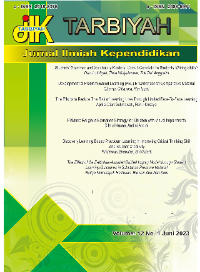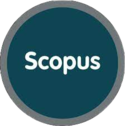Non-Cognitive Diagnostic Assessment of Class 7 Islamic Education Learning at Junior High School
DOI:
https://doi.org/10.18592/tarbiyah.v12i2.10973Keywords:
Al-Quran, non-cognitive diagnostic, students, Islamic religious educationAbstract
The research was conducted to determine the implementation of non-cognitive diagnostic assessment of the ability to read and write hijaiyah letters and write Al-Quran verses, the results of non-cognitive diagnostic assessment of the ability to write hijaiyah letters and Al-Quran verses of 7th-grade students at SMPN 3 Lembang. The research design used a qualitative approach with a field study method of 305 students in grades 7D-7K with descriptive quantitative data analysis. The results revealed that in conducting the assessment, the teacher compiled an assessment rubric and used the percentage formula to measure the ability to read and write the Quran. Then, in general, the ability to read the Al-Quran of students in grades 7D-7K is categorized as fluent in as many as 148 students (49%), and their ability to write hijaiyah letters and Al-Quran verses is categorized as proficient in as many as 225 students (74%). This study concludes that no students can read the Quran and cannot write hijaiyah letters and Quranic verses. The implication of this study can be used as a basis for making non-cognitive diagnostic assessment instruments of the ability to read and write the Quran for learning preparation within the framework of an independent learning curriculum at all levels, specifically at the junior high school level in PAI subjects.References
Burhanudin, A., & Meihadi, F. (2019). Kesulitan Siswa Dalam Membaca Tulis Al-Quran Hubungannya Dengan Motivasi Siswa Dalam Keikutsertaan Pelajaran PAI. Al-Mau’izhoh, 1(2), 1–12. https://doi.org/http://dx.doi.org/10.31949/am.v1i2.1672
Culver, C. (2023). Learning as a Peer Assessor: Evaluating Peer-Assessment Strategies. Assesment & Evaluation in Higher Education, 48(5), 581–597. https://doi.org/https://doi.org/10.1080/02602938.2022.2107167
Dam, D. J. Van, Eller, J. L., & Swezey, J. A. (2021). Developing Leadership as a Federal Service Academy Peer Tutor. Journal of College Reading and Learning, 51(4), 250–266. https://doi.org/https://doi.org/10.1080/10790195.2021.1928567
Datadidaksmen. (2023). Asessmen Diagnostik Kognitif dan Non Kognitif Implementasi Kurikulum Merdeka. Https://Www.Datadikdasmen.Com/2023/07/Asessment-Diagnostik-Kurikulum-Merdeka.Html.
Dewi, Y. S. (2021). Analisis Kemampuan Membaca dan Menulis Al-Quran Mahasiswa Angkatan 2019 Prodi Pendidikan Agama Islam UIN Raden Intan Lampung. http://repository.radenintan.ac.id/16567/1/PERPUS%20PUSAT%20BAB%201%20DAN%202.pdf
Gusman. (2017). Analisis Faktor Penyebab Kurangnya Kemampuan Siswa dalam Bacca Tulis Al-Qur’an di MTsN Kedurang Bengkulu. Al-Bahtsu: Jurnal Penelitian Pendidikan Islam, 2(2), 231–238. https://doi.org/http://dx.doi.org/10.29300/btu.v2i2.693
Husna, S., Azizah, M., & Espiyati. (2023). Implementasi Asesmen Diagnostik Non Kognitif Siswa Kelas III SD Negeri Gayamsari 02 Kota Semarang. Didaktik: Jurnal Ilmiah PGSD STIKP Subang, 9(2), 6037–6049. https://doi.org/https://doi.org/10.36989/didaktik.v9i2.1390
Ismail. (2009). Implementasi Pendidikan Agama Islam di Sekolah Menengah Umum (SMU) (Problematika dan Pemecahannya). Forum Tarbiyah, 7(1), 33–53.
Kusumastuti, A., & Khoiron, A. M. (2019). Metode Penelitian Kualitatif. Lembaga Pendidikan Sukarno Pressindo (LPSP).
Marbella, H. W., & Rusman, A. (2023). Implementasi Pembelajaran Merdeka Belajar pada PAI dalam Meningkatkan Keaktifan dan Kreativitas Siswa. Risalah: Jurnal Pendidikan Dan Studi Islam, 9(2), 760–774. https://doi.org/https://doi.org/10.31943/jurnal_risalah.v9i2.477
Maulani, A., Ayu, S. M., Dermawan, O., & Akmansyah, M. (2021). The Development of Android-Based Islamic Education Learning Media. Tarbiyah, 10(1), 35–43. https://doi.org/https://doi.org/10.18592/tarbiyah.v10i1.4410
Meilina, A. (2023). Pentingnya Melakukan Asesmen Diagnostik Kognitif dan Non-Kognitif Sebelum Kegiatan Pembelajaran. Https://Blog.Kejarcita.Id/Pentingnya-Melakukan-Asesmen-Diagnostik-Kognitif-Dan-Non-Kognitif-Sebelum-Kegiatan-Pembelajaran/.
Mustolih. (2023). Analisis Kesulitan Membaca Al-Quran Peserta Didik Kelas Rendah di SD Negeri 120 Rejang Lebong. http://e-theses.iaincurup.ac.id/3237/1/Analisis%20Kesulitan%20Membaca%20Al%20Qur%27an%20Peserta%20Didik%20Kelas%20Rendah%20di%20SD%20Negeri%20120%20Rejang%20Lebong.pdf
Nalysta, J. O., & Kosasih, A. (2021). Analisis Kesulitan Membaca dan Menulis Alquran Peserta Didik di Sekolah Menengah Pertama. An-Nuha: Jurnal Pendidikan Islam, 1(2), 71–78. https://doi.org/https://doi.org/10.24036/annuha.v1i2.26
Nasution, S. (2016). Faktor-faktor yang Mempengaruhi Kemampuan Baca Tulis Al-Qur’an Siswa SMPN 2 Batangtoru Kecamatan Batangtoru Kebupaten Tapanuli Selatan. https://etd.uinsyahada.ac.id/373/1/11%20310%200128.pdf
Numan, A. Q., & Islam, M. S. (2021). An Assessment of The Teaching and Learning Process of Public and BRAC Primary Schools in Bangladesh. Education 3-13, 49(7), 845–859.
Pahrina, & Surawardi. (2017). Kemampuan Peserta Didik dalam Membaca dan Menulis Al-Quran di SMPN 4 Takisung Desa Kuala Tambangan Kecamatan Takisung Kabupaten Tanah Laut. Tarbiyah Islamiyah: Jurnal Ilmiah Pendidikan Agama Islam, 7(1), 26–36. https://doi.org/https://doi.org/10.18592/jtipai.v7i1.1795
Rahmadi. (2011). Pengantar Metodologi Penelitian. Antasari Press.
Reznicek-Parrado, L. M. (2023). Peer-to-peer Translanguaging Academic Spaces for Belonging: The Case of Spanish as a Heritage Language. International Journal of Bilingual Education and Bilingualism, 26(2), 131–145. https://doi.org/https://doi.org/10.1080/13670050.2020.1799320
Risnawati, Rizqa, M., Agustina, A. M., Mastura, N., Qadri, W., & Husni, R. (2023). Jenis Evaluasi Pembelajaran Pendidikan Agama Islam. Journal Education and Islamic Studies, 1(2), 108–118. https://doi.org/https://doi.org/10.55062//JEDIES.2023.v1i2.333/4
Salim, & Syahrum. (2012). Metodologi Penelitian Kualitatif. Ciptapustaka Media.
Santosa, T. A., Zulyusris, Abi Suwars, & Amalia, K. N. (2021). The Educational and Learning Problematic at Senior High School. Tarbiyah, 10(1), 18–24. https://doi.org/https://doi.org/10.18592/tarbiyah.v10i1.4124
Setiawan, A. (2020). Peningkatan Kemampuan Siswa dalam Menulis AlQuran Melalui Media Card Sort (Penelitian Tindakan Kelas di SDN Gandaria Utara 07). https://repository.umj.ac.id/4676/1/SKRIPSI.pdf
Shofiyah, N., & Sartika, S. B. (2018). Buku Ajar Mata Kuliah Asesmen Pembelajaran. UMSIDA Press.
Solihah, E., Nafisyah, S. S., Dewi, W. P., & Aeni, A. N. (2021). Analisis Kemampuan Siswa dalam Menulis Huruf Al-Quran di SD Umum dan Berbasis Islam. Elementeris: Jurnal Ilmiah Pendidikan Dasar Islam, 3(2), 29–42. https://doi.org/https://doi.org/10.33474/elementeris.v3i2.11124
Sulistyowati, Rahmad, Gofur, A., Jasiah, Syabrina, M., Syar, N. I., & Mahmudah, I. (2023). Pelatihan Implementasi Kurikulum Merdeka di MIN 2 Kota Palangka Raya. Jurnal Pengabdian Kepada Masyarakat Nusantara, 4(2), 888–895. https://doi.org/https://doi.org/10.55338/jpkmn.v4i2.966
Tan, S. C., Looi, C. K., Cheung, Y. L., Chung, S. H., Lim, S. J., & Wong, W. H. (2023). Designing and Evaluating a Mobile Peer Tutoring Application: a Cultural Historical Activity Theory Approach. Interactive Learning Environments, 31(8), 4806–4817. https://doi.org/https://doi.org/10.1080/10494820.2021.1983608
Umami, M. (2018). Penilaian Autentik Pembelajaran Pendidikan Agama Islam dan Budi Pekerti dalam Kurikulum 2013. JK: Jurnal Kependidikan, 6(2), 222–232. https://doi.org/https://doi.org/10.24090/jk.v6i2.2259
Waseso, I., Amini, M., & Tatminingsih, S. (2014). Evaluasi Pembelajaran TK. Universitas Terbuka.
Xiang, X., Yuan, R., & Baohua, Y. (2022). Implementing Assessment as Learning in The L2 Writing Classroom: a Chinese Case. Assesment & Evaluation in Higher Education, 47(5), 727–741. https://doi.org/https://doi.org/10.1080/02602938.2021.1965539
Downloads
Published
How to Cite
Issue
Section
License
Copyright (c) 2023 Ali Anhar Syi'bul Huda, Gusti Putri Khairina

This work is licensed under a Creative Commons Attribution 4.0 International License.
Authors retain copyright and grant the journal right of first publication with the work simultaneously licensed under a Creative Commons Attribution 4.0 International License that allows others to share the work with an acknowledgment of the work's authorship and initial publication in this journal.




